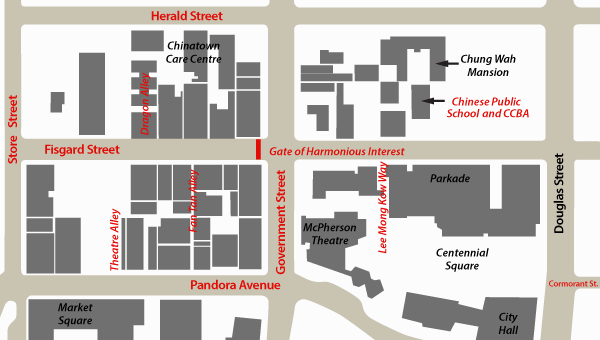- Home
- History
- Community
- Organizations
- Chinese Consolidated Benevolent Association
- Victoria Chinese Canadian Veterans Association
- Chinese Public School
- Clan Associations
- County Assocations
- Dialect Assocations
- Friendship Associations
- Political Organizations
- Recreational Associations
- Religious Organizations
- Women's Associations
- Other Organizations
- People
- Resources
- Contact
Store Street
West Boundary of Chinatown
Store Street served as the western boundary of Chinatown as it extended north from Cormorant (Pandora at present) to Fisgard and Herald over the late nineteenth and early twentieth centuries. Located across the street from the Esquimalt and Nanaimo Railway, which reached its southern terminus of Victoria in 1888, Store Street was an ideal spot for warehouses. John A. Scott, William Peden, and John Peden, owners of the Scott and Peden feed and grain company, gained ownership of three buildings at the corner of Cormorant and Store Street. In 1912, they bought a lot on this corner and built a three-storey warehouse that was connected to the E & N Railway by a short spur, so that feed and grain could be directly transferred on and off the train into storage. This building was converted to a residential and commercial building in 1987 and is currently the site of Swan’s Hotel and Brewpub. Scott and Peden built an additional warehouse next door on Store Street in 1913, and in 1927, they purchased the adjacent King Tye Building on Cormorant Street. The Lim Dat Building, constructed in 1898, on the corner of Fisgard and Store is striking for its Romanesque-style arches and extensive windows. Lim Dat and Wong Soon Lim bought this building in 1898 and sold it in 1909 to Francis M. Rattenbury, the architect who designed the Empress Hotel and the Parliament Buildings.
Sources
Lai, David Chuenyan. The Forbidden City within Victoria: Myth, Symbol and Streetscape of Victoria’s Earliest Chinatown. Victoria: Orca Book Publishers, 1991.


